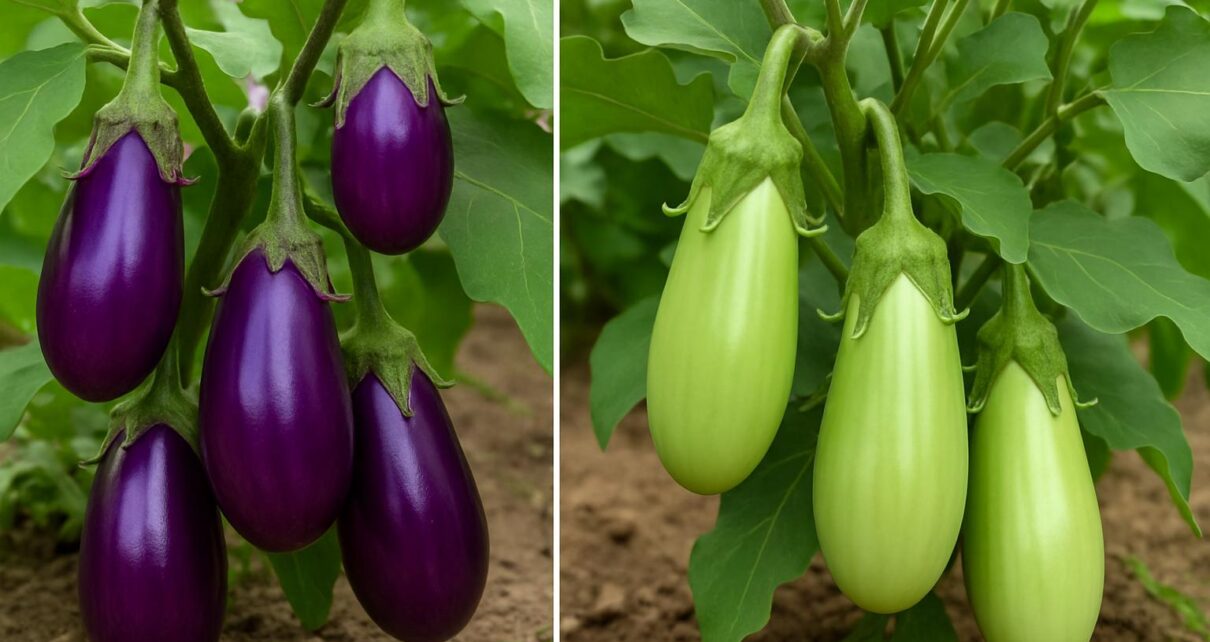Choosing the right brinjal variety is more than just a matter of personal preference for colour. For farmers, it’s a decision that directly affects yield, pest resistance, market demand, and overall profitability. Purple and green brinjals (eggplants) may belong to the same species, Solanum melongena, but they differ significantly in their attributes, performance, and commercial viability. This makes variety selection a strategic decision that varies based on region, soil, and buyer expectations.
In sections of the Mediterranean, Africa, and South Asia, both varieties have been grown for generations. Brindal is one of the most extensively farmed vegetables in the world because of its durability, rapid harvest cycle, and flexibility. Recent research, however, suggests that purple and green cultivars differ significantly in several characteristics, including fruit weight, anthocyanin content, and insect tolerance.
What Sets Purple Brinjal Apart?
The most popular type of brinjal in the world is the purple variety. Its high anthocyanin content, a naturally occurring antioxidant with well-established health benefits, gives it its deep violet skin. In some locations, this pigment also gives the cultivar its tolerance to heat and pests.
Purple varieties are known for:
- Strong antioxidant properties (rich in nasunin and chlorogenic acid)
- High adaptability in semi-arid zones and red loamy soils
For example, due to their reliable yield and resistance to Phomopsis blight, the Pusa Purple Long and Arka Kusumkar cultivars are widely used in India. Usually weighing 80–150g each, these brinjals have a thick, glossy skin that keeps well after harvest.
Traits That Make Green Brinjal Unique
Due to its unique flavor, reduced bitterness, and lighter texture, green brinjal types are gaining popularity. In Bangladesh, Tamil Nadu, and Maharashtra, they are frequently popular in local markets where traditional recipes favour their delicate flavour.
Green brinjals tend to:
- Have a thinner skin with a softer pulp
- Be less bitter, making them ideal for curry dishes and stuffing
- Exhibit better fruit set in cooler regions and during kharif season
Green Long and Arka Harita are two varieties that are valued for their short maturity cycles and consistent shape. Due to improved flower-to-fruit conversion, particularly in greenhouses and high tunnels, the average yield is slightly higher under controlled conditions.
Many smallholders now consider consumer preferences and culinary uses when planning crop cycles before selecting a cultivar. Targeted cultivation presents a lucrative potential because the demand for green brinjal is frequently associated with particular ethnic populations and niche gourmet markets.
Performance Across Soil and Climate Conditions
Both purple and green brinjal require well-drained soils with pH between 6.0–7.5. However, certain differences emerge when planted across agro-climatic zones:
- Purple brinjal resists drought better due to deeper root systems
- Green brinjal performs better in humid subtropical zones with adequate shade
Purple cultivars are frequently preferred by farmers who produce in light-textured soils because they can withstand nutrient shortages. Green brinjals, on the other hand, grow their foliage more quickly and react better to organic manure and vermicompost.
Crop rotation between the two varieties can lessen insect accumulation and soil-borne diseases in areas where both are grown.
Under the same fertilisation strategies, green types exhibited 12% higher chlorophyll content and 18% faster flowering, according to a recent experiment by the Indian Institute of Vegetable Research.
Pest Resistance and Disease Tolerance
Purple brinjals generally offer better resistance to:
- Shoot and fruit borer (Leucinodes orbonalis)
- Bacterial wilt (Ralstonia solanacearum)
- Fusarium wilt and collar rot
Green brinjals are more susceptible to insect damage, especially in flowering stages. However, they compensate with quicker recovery and regenerative growth.
Integrated pest management (IPM) strategies vary for both types:
- Purple: fewer insecticide sprays, longer intervals between treatments
- Green: frequent scouting, neem-based biopesticide applications
Because of this, purple brinjals are more appropriate for organic or low-input systems where reducing the amount of chemicals used is essential. Green types, on the other hand, need more care but, in systems that are well maintained, can yield greater returns.
Market Demand and Pricing Trends
National markets are dominated by purple brinjal, especially in metropolitan retail chains. According to a 2022 market estimate by AgriPriceMonitor, it makes for around 72% of all brinjal sales in India. Better margins for growers aren’t always the result of this domination, though.
In specialty markets, green brinjal commands premium prices; in farm-to-fork operations, it frequently commands 15–25% higher rates per kilogramme. Chefs and consumers seeking culinary-grade vegetables are drawn to them because of their softness and visual appeal.
In weekly markets:
- Purple brinjal averages ₹18–₹24/kg depending on size and season
- Green brinjal averages ₹25–₹32/kg in specialty segments
With green brinjal as a unique selling proposition, some urban farms are now utilising direct-to-consumer business models. Adding storytelling to the variety—such as heirloom provenance or seed-saving practices—can boost commercial appeal.
For farmers aiming to access this premium segment, it’s best to Buy Brinjal Seeds Online from certified platforms offering both open-pollinated and hybrid options with disease resistance markers.
Growth Duration and Harvesting Cycle
Typically, purple cultivars need 100–120 days to mature. During peak season, they consistently produce every three to four days, with a harvest window of six to eight weeks. This minimises waste and permits several pickings.
Under comparable nutrient regimens, green brinjals develop more quickly and have a little shorter maturity time (typically 90–110 days). They are more timing-sensitive, though, and their harvest window is smaller.
In areas with limited labour availability, purple varieties are easier to manage due to:
- Higher fruit firmness
- Delayed post-harvest deterioration
- Better shelf life (4–6 days at room temperature)
Green brinjals need to be refrigerated or transported to the market right away because they lose their firmness quickly. However, they have superior cooking qualities and better natural sugar retention when gathered at the ideal time.
“It’s not about choosing the most popular variety, it’s about matching the brinjal’s character with your soil, climate, and market expectations.”
Comparative Table: Purple vs Green Brinjal Traits
| Feature | Purple Brinjal | Green Brinjal |
| Skin Pigment | High anthocyanin | Low anthocyanin |
| Avg. Maturity Days | 110 | 100 |
| Pest Resistance | High | Moderate |
| Market Price Range | ₹18–24/kg | ₹25–32/kg |
| Shelf Life | 5–6 days | 2–3 days |
| Flavor Profile | Mildly bitter | Sweet and soft |
| Ideal Conditions | Semi-arid, loamy soils | Humid, cool climates |
Flavor, Culinary Uses, and Customer Preferences
Recurring sales are significantly influenced by consumer preference. The somewhat bitter undertone of purple brinjals complements grilled foods, baingan bharta, and sambar. Long cooking preserves the structure of their stronger skin.
Green brinjals are ideal for stir-fries, filled dishes, and curries like bharli vangi because they are sweeter, softer, and better at absorbing spices. Because of their melt-in-mouth feel, green types are often favoured in regional cuisines such as Konkani and Chettinad.
According to some culinary studies, green brinjals have better taste profiles because they have higher levels of glycoalkaloid when they are immature. This is important to chefs when creating local food trails or seasonal menus.
The decision between purple and green often boils down to the farmer’s strategy for positioning the food, whether for premium farm-fresh boxes, contract farming, or bulk sales.
Environmental and Resource Considerations
These days, farming is motivated by sustainability as much as profit. Watering green brinjals more frequently is necessary, particularly when they are blooming. If they are not shaded, they show moderate signs of withering in hot weather.
Purple cultivars use less water and are less susceptible to short-term stress. Even in fields with varying nutrition levels, they provide consistent crops.
Utilising drip irrigation and mulching aids green brinjal farmers in preserving moisture and minimising physiological fruit drop. Legumes are a good way to increase soil nitrogen availability and early plant vigour before planting either kind.
Resources from The National Horticulture Board provide up-to-date information on soil management, insect forecasts, and varietal performance studies to help you better understand sustainable brinjal growing methods.
FAQs
- Which variety yields more per acre?
Purple brinjals generally yield more per acre due to better pest resistance and consistent flowering. On average, yields range between 15–18 tons/acre for purple and 13–16 tons/acre for green. - Are green brinjals more nutritious?
Both have similar nutritional values in terms of fiber, potassium, and vitamin B1. Purple brinjals have higher antioxidants; green ones have a better mineral absorption rate when cooked. - Do hybrid seeds exist for both types?
Yes. Hybrid and open-pollinated varieties are available for both green and purple brinjals, each suited to different farm scales and climates. - Which variety is best for organic farming?
Purple varieties adapt better to organic systems due to fewer pest attacks and better tolerance to stress without chemical inputs. - Can I grow both varieties in the same plot?
Yes, with sufficient spacing and separate rows. Crop rotation and intercropping with marigold or basil can also reduce pest impact on both.
What’s Next for Smart Brinjal Cultivation?
Today’s farmers are agri-entrepreneurs as well as cultivators. Direct market access, data-driven variety selection, and diversification are key components of brinjal farming’s future. The brinjal has greater promise than ever before, whether it’s cultivating heirloom kinds for farm tours or investigating hydroponic eggplants.
Common crops like brinjal are increasingly being used to test new precision farming technologies including blockchain-enabled food traceability and AI-based crop health monitoring. The way this staple is cultivated, promoted, and consumed may vary if they are combined with traditional knowledge.
“Purple or green” is no longer the only question. It’s how to use each plant to further the long-term objectives of your farm.
Checkout more : This Is What Happened When I Combined Systemic and Contact Pest Control




